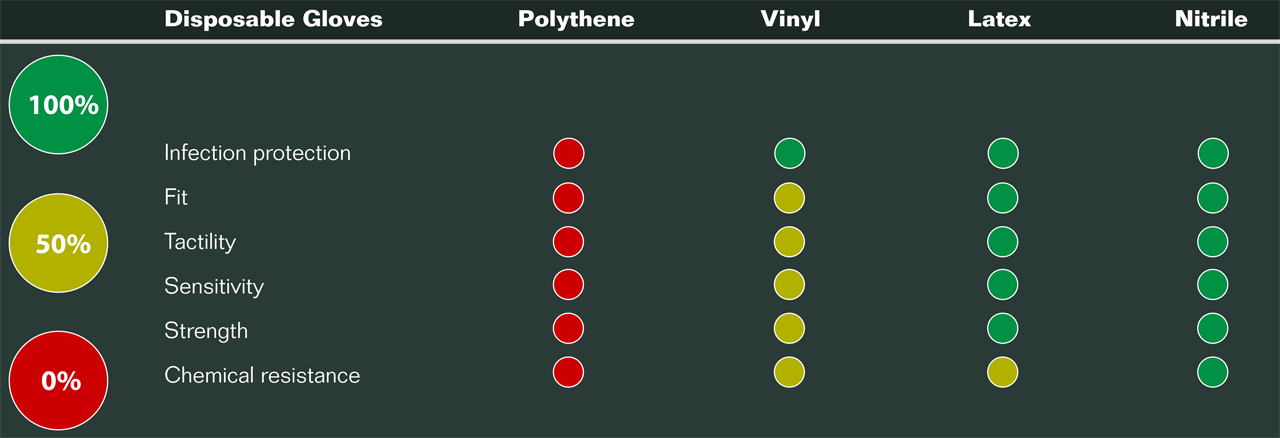
Doctors, nurses, caregivers, dentists, and other healthcare workers typically use examination gloves. The risk of the job should be taken into account when deciding between latex, vinyl, and nitrile exam gloves. Latex and nitrile gloves are commonly used when dealing with high-risk situations involving blood, bodily fluids, or patients with infectious diseases. Both latex and vinyl gloves can be used for low-risk, general procedures such as a non-invasive physical exam. Surgical gloves are of higher quality and designed specifically for the accuracy and sensitivity required by surgeons.
Sterile vs. Non-Sterile Gloves
Sterile gloves are used primarily for surgical purposes. Sterile gloves must meet regulatory standards based on an acceptable quality level of pinholes. Sterile gloves have a lower acceptable quality level compared to non-sterile gloves. Due to the stricter standards, sterile gloves are more expensive than non-sterile gloves. Studies show that in non-surgical procedures, there is no link between using non-sterile gloves and increased rates of infection. Therefore, most healthcare workers opt for non-sterile gloves for non-surgical procedures.
Does Glove Colour Matter?
While usually a matter of preference, colour can be of some importance. Some practices or hospitals using different types of gloves may purchase different colours so they are easily identifiable. This can be beneficial to those with a latex allergy.
Colour can also be significant to some surgeons who double-glove. Double gloving is the practice of wearing a second pair of gloves over the first, as research shows this may help protect the first pair from damage. By wearing a light-coloured glove underneath a dark-coloured glove, or vice-versa, tears or punctures can be more readily identified when double-gloving.
Powder vs. Powder Free Gloves
Cornstarch is used in powdered gloves which makes it easier to slip the glove over the hand. Powder from gloves can be an issue if it gets into wounds or exposed body tissue during surgery as it can slow down the healing process. This is the reason most surgical procedures require powder-free gloves, and manufacturers now use special processes to give them the same easy on/off properties of powdered gloves.
Latex Gloves
| Advantages | Disadvantages |
|---|---|
| Comfort and dexterity | Risk of an allergic reaction to natural rubber |
| Easy to put on, greater flexibility | Thinner gloves cause more pinholes and tearing |
| Polymer coating replaces cornstarch powders | Dissolves when in contact with oils, grease, and other hydrocarbons |
| Best fit, comfort, and flexibility | |
| Effective barrier against biological contaminants |
Latex Gloves
- Sets the standard for great fit and comfort
- Flexible- available for use in exam and sterile surgical applications
- High level of sensitivity
- Durable / high-strength
- Mid-level barrier protection
- Not suitable for those with latex allergies
- Can cause the development of latex allergy when used often
Nitrile Gloves
| Advantages | Disadvantages |
|---|---|
| No allergic reaction to natural rubber | Dissolves when in contact with acetone |
| Improved polymer technology creates a more comfortable fit | Powdered versus Powder-Free |
| Increased demand and manufacturing methods make it more affordable | |
| Best puncture and abrasion resistance | |
| Great latex alternative for individuals with allergies |
Nitrile Gloves
- Stronger than vinyl or latex
- For use in examination applications
- Available in sterile or non-sterile
- Greater protection from chemical exposure
- Protein and latex-free
- High-level barrier protection
Vinyl Gloves
| Advantages | Disadvantages |
|---|---|
| The most cost-effective choice for small medical offices | Frequent glove changes are required and a basic barrier will suffice. |
| Great for short-term jobs where comfort is not a concern | Vinyl gloves have the lowest puncture and chemical resistance. |
| Vinyl gloves are less elastic than latex and nitrile, so when you choose this type, you sacrifice comfort and fit. |
Vinyl Gloves
- Economical, low cost
- For use in examination applications only
- Less durable- more likely to tear or be punctured
- Standard-level barrier protection
- Latex-free for those with allergies
- Made from polyvinyl chloride
Glove Sizes
Glove sizes vary by manufacturer and glove type. You should always make sure your glove is a good fit and comfortable to work in. It is best to consult the manufacturer prior to purchasing. Often, the manufacturer will have a size chart available on their website.
That said, manufacturers have made advancements to improve the fit and feel of vinyl gloves, which has allowed multiple generations of them to exist in the market. For example, 3G vinyl (a patented third-generation stretch vinyl) is the most advanced to date.